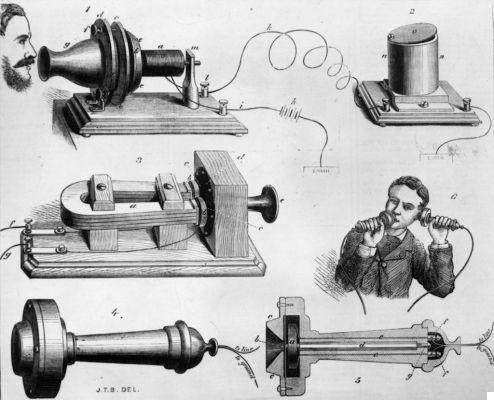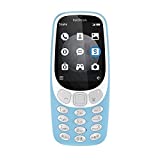If you are old enough to remember the telephone with rotary disk keypad grandmother's, you won't struggle to realize how much this tool has changed over the years. By now, in 2020, it even seems outdated the cordless, despite having represented a real revolution in the world of telephony.
Indeed, the landline itself seems to be "prehistoric". Especially now that we communicate with WhatsApp, Zoom, Google Meet, Skype and who knows what else. The evolution of technology is going so fast that it forces us to forget the history of an object. Or not to know it at all. That's why today we decided to tell you about it how the phone has changed, so as to really know where one of the devices we are most fond of today comes from.
The quarrel between Bell and Meucci, or the birth of the telephone
The birth of the telephone hides a rather curious story. Officially, its inventor is Alexander Graham Bell, a British engineer who filed the patent for "the method and apparatus for transmitting voice or other sounds by means of electrical undulations". It was March 7, 1876, and Bell earned a place in history by stealing the idea from the Italian Antonio Meucci. This Florentine who emigrated to New York had already invented the telephone in 1854, an instrument he used at home to talk to his wife, bedridden by deforming arthritis.
Meucci did not enjoy great economic prosperity, and so he could only afford the payment of a temporary patent. It was 1871, and no telegraph company showed interest in his project. Alexander Bell, however, immediately noticed the great potential of the Italian's project. And so he filed his personal definitive patent in 1876, earning the title of "inventor of the telephone". Poor Meucci decided to sue him but, given his bad luck, he lost it.
Only about ten years later the Supreme Court of the United States recognized the Florentine's reason for the first time. But it was too late. Meanwhile Bell had managed to build a real telecommunications empire, thanks to the success of his Bell Telephone Company. A sad story that of Antonio Meucci, who was recognized as the paternity of the telephone only in 2002, when this device had taken on a completely different form and social connotation.

Habemus phone!
Bell's phone consisted of a microphone (the transmitter) and of a speaker (the receiver), connected together by an electrical circuit equipped with a battery in series. Basically, speaking inside the transmitter, the voice reached directly to the ear of the person holding the receiver in his hands. Broadly speaking, exactly how it works today. Before this device there had been prototypes of all kinds, including the so-called "lover's phone".
It is nothing more than a two cans, connected to each other by a thread or a rope. Speaking holding the tin close to the mouth, the vibrations of the voice run along the wire and arrive amplified at the ear of the interlocutor. The wireless phone you used to have fun teasing your friends with in elementary school. Only we used it to make our comrades repeat nonsense words, and Bell's peers for all important communications. The world really changes in 150 years, don't you think?
In the following decades it was all a continuous evolution. I arrived first rotating dials, very useful but incredibly uncomfortable. To dial a phone number you had to spin a wheel on which the numbers were written. And in the event of a mistake, you had to start all over again. A sort of agony in an emergency phase. In the 30s, the so-called telefoni a candelabro. Basically, they consisted of a base that acted as a transmitter - the candlestick, in fact - and a receiver, which had to be held to the ear for the entire course of the call. Soon the receiver will take the form of the handset, considered one of the distinctive elements of the device.
Over the years, candlestick telephones disappear and homes begin to fill with extravagant wall-mounted telephones - bulky, yet functional. Fortunately, between the 60s and 70s of the twentieth century the first telephones connected with a cable to the telephone socket began to arrive. Then comes the keyboard too. And finally this device begins to have the look (or almost) that we all know today.

Motorola is the first mobile phone
During the 70s, as the landline was changing shape and preparing to become cordless, Martin Cooper worked at first mobile phone in history. To be exact, on April 3, 1973, this young engineer employed by Motorola used a cell phone to call Joel Engel of Bell Labs, one of the major competitors in the telephony industry. Apparently, these would have been Cooper's words: “Hey Joey, it's Martin. I'm calling you from a cell phone, a real cell phone ". The young Ukrainian, hired by Motorola in 1954, rightly took credit for one of the most incredible inventions in history, on which he had worked for almost twenty years.
READ ALSO: Foldable smartphones are the future (and past) of telephony
The cell phone from which Cooper called was the prototype of the Motorola Dynatac 8000x, launched on the sol market in 1983, after 10 years of refinements and improvements. As for its appearance, let us tell you it was not quite what we imagine it to be. Just to give you an idea: the telephone weighed 1.1 Kg, it did not have a screen but it did have an antenna, and it was equipped with a battery of the duration of about half an hour, with a charging time of 10 hours. When it was launched on the market, it cost ben 4000 $. An investment that only a lucky few could afford.
Cooper's Motorola already had some interesting functions, such as the ability to store 30 numbers or the ability to use keys for volume, callback and lock. But it was really very heavy to be considered a portable phone, shall we say. In the following years, therefore, the various companies in the sector did nothing but work to solve this "problem".

From mobile to smartphone: thirty years of evolution
Let's face it: carrying around a kilo cellphone didn't have to be comfortable. Assuming that someone really managed to get out of the house by putting the phone in their pocket. Fortunately, even before becoming known for Snake and the 3310, Nokia was able to bring a lighter mobile phone to the market, the Mobyra Cityman 900, which went down in history with the nickname of “Gorba” because it was immortalized in the hands of Michail Gorbačëv in a snapshot of the time. The appearance was very similar to that of the previous Motorola, but with a slightly less weight: 800 grams.
We are in 1987, when the big companies are still working to improve the Martin Cooper project. But here it is in 1992 IBM amazes everyone launch the first smartphone prototype in history. It is about Simon, a device without a physical keyboard, but equipped with a touch screen that could be operated with a stylus. A forerunner of the Note? Something similar. Unlike his predecessors, Simon was equipped with a calendar, calculator, notepad, world clock, and email client. And as if that weren't enough, for the first time a phone was sold with a video game installed, Scramble.
The idea of IBM particularly pleased Nokia, considered one of the leading companies in the telephony sector in the 1996s. And here in XNUMX the model appears on the market 9000 Communicator, the first telephone with an extended keyboard that allowed you to send and receive e-mails. And this was not the only novelty. The Nokia phone was equipped with a double display and a lithium battery that ensured a duration of 35 hours of standby time and 3 hours of talk time. A great leap forward in just 10 years of history.

In the years that followed, Nokia's successes were incredible. The 5210 arrived, the first water-resistant mobile phone, and then the 3210, the first with the T9 writing system - a sort of predictive text, for the uninitiated -. Then the incredible 3310, of which 126 million pieces were sold. And then again the 3510, the first phone equipped with Integrated GPRS and also a color display. In short, the Finnish company has really opened the dance to a sector that has evolved very quickly. So much so that it is really difficult for us to follow the history of the phone step by step.
Let's take a big leap forward and arrive in 2007, when Apple presents its cousin iPhone and radically changes the concept of mobile phones. And telephony. A decade was enough to allow the market to make the telephone an indispensable tool, useful for any function and not just for simple calls. Unlike the Cooper era, when the cell phone was considered an object for a select few, now it is absolutely the opposite. We are all obsessed with the race to the latest model, thus contributing to a real social revolution. The one in which we look at the display even when we are sitting at the table, instead of looking into each other's eyes.
 Nokia 3310 3G Mobile Phone, 64MB Internal Memory, ...
Nokia 3310 3G Mobile Phone, 64MB Internal Memory, ...
- Fotocamera: 2 MP, flash LED
- Memory: 0,064 GB expandable with 32 GB MicroSD
- Battery Type: Removable BL-4UL (1200mAh) 2
 Nokia 3310 Mobile phone 2.4 "((6,1 cm) 2 MP, ...
Nokia 3310 Mobile phone 2.4 "((6,1 cm) 2 MP, ...
- Available languages: English, French, German, Dutch, Turkish
- 16 MB RAM. With microSD card expandable to 32 GB.
- FM Radio e MP3 Player


























